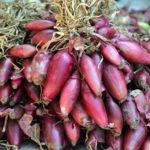Learn all about poinsettia care after Christmas and how to keep your poinsettia alive.

Poinsettias are a very popular plant around the holidays. After Thanksgiving, many people bring home a poinsettia plant and place it on the mantel in front of a picture window.
Although poinsettias are festive and lovely with their red leaves, caring for them isn’t necessarily easy.
Often times you’ll hear that Poinsettias are temperamental or only bloom for the people the plant chooses.
You can have success growing Poinsettias if you know how to care for them. Here are some tips to get you started with successful Poinsettia care.
A word of warning that Poinsettias are considered poisonous. They aren’t as poisonous as there were previously thought, but it’s still good to be aware of.
Table of Contents
History

Poinsettias are short day plants, just like the Christmas Cactus. This means that they bloom when the days are shorter and there are less hours of sunlight.
Poinsettias are tropical plants from Mexico and Central America. They grow as small shrubs or trees.
In Mexico, the poinsettia is known as the flower of the holy night.
In the late 1820’s, they were brought to the US by Joel R. Poinsett.
Colors

While we typically see red poinsettias, you can actually find this plant in several different colors. Such as white, pink, yellow, and variegated.
The leaves of the poinsettia are dark green and glossy, while the bracts (red leaves) vary from deep pink to bright red. When we think of the poinsettia flowers being red, this is actually the bract or colored leaves.
Poinsettias do flowers and the flowers are very small, in the center of the bracts.
Light Requirements
Light is very important to poinsettia plants in order for them to stay healthy. They love to be in a lot of indirect sunlight.
So, make sure to place your poinsettia in an area that gets lots of natural, bright, indirect light.
Temperature and Humidity
Poinsettias are tropical plants and just like you would expect, they like warmth and humidity.
Poinsettias should be kept above 60 degrees Fahrenheit during the day and above 50 degrees at night.
While many types of plants enjoy warm conditions, poinsettias will drop their leaves if exposed to drafts or cold temperature.
Watering

Poinsettias like to dry out a little between watering. During the winter months, water about every two weeks. You’ll want to water more often during the summer such as every 7-10 days.
When you water, make sure to water the plant thoroughly. Let all the water drain after watering it, so it isn’t sitting in water.
Soil and Repotting

If your poinsettia is rootbound, you’ll want to repot it. April and May are good times to do this as the plant has died back some.
Choose a pot that is a size larger than the pot your poinsettia is in.
You also want to make sure the soil you use is well draining. You can mix succulent soil with regular potting soil.
Fertilizer
You can fertilize your Poinsettia plant once a month, using a weak fertilizer. For example, a 15-15-15 fertilizer with the strength cut in half is a good one to use.
Pruning
In the spring, prune your Poinsettia to about 4 or 5″. You’ll know it’s time when most of the leaves have fallen off.
Tips for Getting Your Poinsettia to Turn Red
In order for your poinsettia leaves to turn red, it needs less daylight.
From the end of September up until early December keep your plant in the dark for 16 hours a day.
General Tips
Keep poinsettias away from drafty areas.
If you live in a warmer climate, you can bring your poinsettia plant outside during the spring and summer. Just make sure to bring it in when the temperature drops below 50 degrees Fahrenheit.
Make sure to take the foil wrapper off once you get your plant home. While it may make the plant look nicer, you poinsettia will like the additional air flow with the foil removed. If you decide to still keep the foil wrapper on, make sure to remove it when watering. Water can get trapped in the foil lining and you will end up overwatering your poinsettia.
Good luck with your poinsettia! You’ll find with the proper care these plants will not only survive, but can thrive and live for years. During this time, you may find your poinsettia grows to be quite large.
Make sure to “PIN THIS” for later!

Other houseplant posts you might like:
Christmas Cactus Care
Christmas Cactus vs Thanksgiving Cactus
Amaryllis Care



